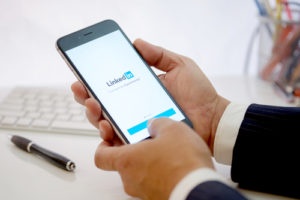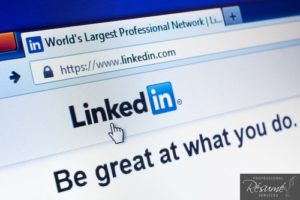LinkedIn is a powerful networking tool for executives. With the high visibility your LinkedIn profile has, even some of the smallest mistakes could be critical. Just like with a resume, your profile has to stand out among the rest if you want to get discovered and considered for any job openings. Understanding how to optimize your LinkedIn profile will go a long way in getting the job you desire. Here are a few tips on how you can soup yours up!
1. Choose an Appropriate Profile Picture
LinkedIn is a social media platform, but it is much different from Facebook, Twitter or other platforms. When working on your LinkedIn profile development, the first thing to find is a professional photo. Your picture is the first thing recruiters will see, so make sure you present yourself in the best light. Save the picture of your family or you and your kids for Facebook. A good rule of thumb to remember is if you wouldn’t put the picture on your resume, it doesn’t belong on your LinkedIn profile. You can have a friend or colleague take a photo of you as well.
2. Customize Your URL
Your profile will automatically be assigned a jumble of numbers and letters at the end of the URL. It would look a lot better and cleaner if you added your name to the end of the URL, especially if you will be sending potential employers the link. It only takes a couple minutes at the most, but it’s a pretty important part of your LinkedIn profile development. Details like this may not seem like a big deal, but they matter to employers and recruiters.
3. Be Detailed and Truthful
Any LinkedIn profile writing expert will tell you to be as detailed as possible without stretching the truth. You have the freedom to write whatever you want on your LinkedIn profile, but employers also have the same freedom to investigate to confirm what you write is true. Trust us: they will check facts!
Unlike the typical resume, which should be fairly short, your LinkedIn profile should be more detailed. When it comes to how to optimize your LinkedIn profile, keywords are critical for being discovered. The more you write, the better chance you’ll have of using keywords to help you get noticed in the search engines.
While it may seem easy to develop your profile, LinkedIn profile writing is more difficult than it sounds. However, with some time and effort, you’ll be able to construct a profile to help get you noticed. If you need any help or advice along the way, just refer back to these three tips and get in touch with us for any other detailed questions you may have.
Constructing a professional LinkedIn profile doesn’t have to be extremely difficult. In fact, just by taking a few simple steps, you can make yourself more recognizable without being overly pushy. When it comes to LinkedIn profile development, you have to understand it needs to be constructed differently from a resume. It’s not a bad idea to upload a resume to your LinkedIn profile, but the rest of the information should be different. This is just one simple tip, but here are some of the best secrets for surviving and thriving on LinkedIn.
Avoid Being Annoying
Have you noticed all of the alerts you receive when your connections have a job change or edit their skills? Your connections also receive those alerts when you make a change! However, you can change the settings to ensure your connections don’t see every little change you make. You might want to broadcast a job change or other important piece of career information, but most people don’t care when you receive a new endorsement.
Take Advantage of Opportunities
Any LinkedIn profile service will tell you to join groups related to your career or prospective career. These groups allow you to make additional contacts and give you the ability to reach out to them without having to upgrade to LinkedIn Premium. Joining several groups will only help you expand your personal brand and get your name recognized among people within your industry.
Be Active
Joining a group is a good step, but being active in the group will make you more recognizable. However, you’ll want to avoid being the annoying person who responds to every thread and has an opinion on everything. As long as you have insightful comments periodically, people will notice you and it will significantly boost your LinkedIn profile development by giving you more connections.
Don’t Use Resume Language
Resume speak should be limited to your actual resume. Any LinkedIn profile writing service will help you rewrite anything that sounds like it came straight from a resume, especially the career summary portion. That should be unique and a bit different from the career summary on your resume. While your LinkedIn profile needs to be professional, it also has to sound conversational and tell people exactly who you are. Look at LinkedIn as an opportunity to showcase your communication skills and other skills that aren’t necessarily as apparent on your resume.
One of the toughest things people experience with LinkedIn is making their profile look professional. It’s easy to slip into casual behavior since it’s an online social network, but LinkedIn isn’t the place for making friends. If you just can’t seem to find the right language or don’t know how to construct your profile, consider reaching out to a LinkedIn profile writing service. You will always benefit from having another set of eyes on your profile and you may find out some other secrets to help take your profile to the next level!
Everyone has a personal brand, whether they know it or not. It’s important for everyone to clearly define their personal brand, but it’s especially critical for high-level executives. As C-level personal branding has increased in importance, the myths surrounding it have also grown in number and prevalence. The truth is many people believe these myths, which can negatively impact their personal branding. Here are the top five myths you should know about, and most importantly, shouldn’t believe.
Myth 1: Your Personal Brand Is Equivalent to Your Reputation
You’re allowed to keep your personal life separate from your business/online life. You may have a completely different reputation with your family and friends than with your business colleagues, and there’s nothing wrong with that!
Myth 2: Personal Branding Isn’t Necessary
Many people underestimate the power of personal branding for senior level managers. Just like a reputation, it takes some time to build a solid personal brand, but it can also be ruined in a matter of seconds. If you think personal branding isn’t necessary, think again.
Myth 3: Personal Branding Is Manufactured
C-level personal branding is only effective if it’s not fake. People who try to make themselves sound better than they really are will only hurt themselves in the long run. Top executives can see right through manufactured personal branding so you won’t be doing yourself any good to create a false personal brand.
Myth 4: Personal Branding Takes a Lot of Time
The art of personal branding for senior level managers isn’t as time consuming as people make it out to be. Yes, you have to work on it a little bit, but you shouldn’t have to spend extra time on your personal brand. Every email you respond to or phone call you take either helps or hurts your personal brand. Just be conscious about your actions and your personal brand will essentially develop itself.
Myth 5: Your Personal Brand Makes You Look Selfish
You may try to make yourself look good on a resume or cover letter, but C-level personal branding is different. As a top executive, you likely have many leadership roles. Being a good leader is one of the best ways to give your personal brand a good image. If you’re able to help others do their jobs better and advance in the rankings, how could you possibly seem selfish?
Most people focus on polishing up their resume, but don’t spend much time thinking about their personal branding. What are you known for? What do you excel at? Many top resume writing services will emphasize your personal brand in your resume, which actually makes it even stronger.
Believe it or not, the majority of employers will review your social media profiles before hiring you. Social media used to be just a fun way to communicate with friends online, but since it’s been booming in recent years, recruiters are also utilizing social media. It basically gives employers free access to see how you interact with others, how clearly you communicate ideas and what you do when you’re not at work. LinkedIn is one of the most popular platforms recruiters use so you need to learn how to optimize your LinkedIn profile before you get on the job hunt!
Optimizing Your LinkedIn Profile
Since LinkedIn is a professional social network, most recruiters will begin their search there. However, many people don’t keep up with their profile and experiences, which could cost them a potential job. If you don’t know exactly what should go on your page, you may consider looking into a LinkedIn profile writing service to help highlight your skills.
Your profile could essentially be your first foot in the door to a potential employer. If they are impressed with your LinkedIn page, you are more likely to be included on their radar. If you don’t have the page filled out or if it’s sloppy, your chances are reduced significantly.
Make It Pop
Users are limited in how they can change their LinkedIn page so you need to make the most of what you have. LinkedIn profile development is a tough skill to master, but it can be done with a little time and effort. In addition to filling out the information on the page itself, you could also design a creative resume to upload. Of course, how creative you get depends on the job you’re searching for, but you get the idea.
Check Other Social Media Platforms
Just because LinkedIn is the main professional social network doesn’t mean employers will only look at it and none of your other pages. You have to assume they will check your Facebook, Twitter and any other pages you may have. Similar to learning how to optimize your LinkedIn profile, you have to do the same with other platforms as well. Remove any embarrassing photos you wouldn’t want an employer to see. So many optimal candidates get passed over because of inappropriate photos, chatter, etc. Go through your communications to make sure you haven’t posted anything offensive that could deter a recruiter. Don’t forget to add privacy settings to all social media you wouldn’t want an employer to see.
Fixing up your social media profiles is probably the first thing you need to do before you even send out your resumes. It only takes a matter of seconds for a recruiter to do a quick search for your name and know a lot about you.
If you’ve followed us for a while, or just have ample knowledge of how job searching and the professional world work, then you know the importance of crafting a personal brand. This is how you appeal to other professionals, especially those who may hire you to work for them later on. The main issue for anyone attempting c-level personal branding, however, is figuring out how to go about it efficiently. In this blog, we’ll give you a few tips on how to brand yourself efficiently and catch the eye of recruiters in an instant!
Include Your Accomplishments
While this goes without saying, your accomplishments within your industry will be some of the most important elements of your personal brand and should not be ignored. The key aspect here is how you incorporate them. You don’t want to splay them all out like playing cards strewn on a table. Rather, you can frame them in a way that appeals more readily to employers.
For a few ideas on how to do this, you can always rely on a team of the best executive resume writers in your area or do a bit of independent research. While you should strive to keep your entire resume brief, you can add a bit of color to your stories by describing them in the form of a (very) brief story—three lines maximum, to be precise.
Think About How You’ve Contributed to Your Industry
This part of brand construction may prove a bit challenging, but it is the perfect method of showing any recruiter or hiring agent how you are a valuable employee. By creating your personal brand, you are effectively telling other professionals a story. Make it appealing by getting to the meat of the action! This means displaying your contributions to the past companies you’ve worked for. It may help to follow the C-A-R formula for these contribution stories, ‘C-A-R’ meaning Challenge, Action and Result. Think about what was being asked of you at the time, how you completed the task at hand and what happened afterward.
Research as Much as Possible
Oftentimes catching a glimpse of others’ work and ideas can help inspire you. If you’re stumped as to how to start or flesh out your personal brand, looking at how others have constructed theirs can give you a boost. We don’t mean lifting someone else’s work entirely, however! Writing an effective resume means showcasing your own strengths and individualizing yourself. Copying someone else entirely defeats the purpose.
As you surf through your Google results and check out what other people are doing, be sure to evaluate your own methods and ideas. How can you apply what they’re doing to your own strengths and accomplishments? Think about how you have influenced your previous employers in ways no one else did. This will help you figure out how to brand yourself well.
Additionally, it may help to get in touch with a professional resume writer to learn what you can do to better market yourself. You may come away with a new perspective toward your career and professional potential that you’ve never considered before, one that will wow employers on the spot!
When you’re in the middle of a job hunt, it can be hard to know which resources to focus on most and which are worth your while. While the Internet—and especially social media—has been brushed off in the past as a means of finding work, it now can serve as an extremely valuable tool during your job search efforts. Here’s how you can make the most of it!
1. Communicate
Social media is just that: social! Now is a prime opportunity to try and reach out to other people in your industry. Many of today’s social media platforms feature chat rooms about a myriad of subjects. You can easily find one related to your chosen industry and get to know other professionals in your area of expertise. They can help point you in the right direction as far as who’s hiring and what’s going on in your field.
2. Take Advantage of Popular Social Media Platforms
Thanks to their widespread usage, you may have come to associate the most popular social media sites, like LinkedIn and Facebook, as either purely for socialization and fun, or are simply skeptical as to whether they can really help you during your job search. As it turns out, this is one situation where you should truly believe the hype!
While sites Twitter, Facebook and others like it are most commonly used for social networking, you don’t want to discount the networking aspect. If you play your cards right and focus your efforts on business, you can use your social media accounts to forge worthwhile connections that can lead you to better job opportunities. Now would be a great time to create your LinkedIn profile if you haven’t already.
3. Google Yourself
While this may sound a bit vain, you’ll want to Google yourself before you set up any social media accounts just for the sake of seeing what comes up. Letting this go unchecked means you risk the chance of potential employers running into something unsavory when (and not if!) they look you up. You’re better off playing it safe and checking up on what’s associated with you on the Internet. Otherwise, it could end up costing you valuable job opportunities.
4. Be Direct
You don’t need to be discreet about your job search! Let those close to you know you’re in the midst of a hunt. You’ll need all the help you can get, and you never know where great connections will come from! Even if they don’t know any people who can directly provide you with work, they’ll be able to keep a look out for opportunities for you.
5. Focus on Networking
One of the best and most important aspects of any social media platform is its ability to quickly and easily put you in contact with millions of people, regardless of location. Be sure to use this to advantage! This will a key element to your Facebook and LinkedIn profile development. By researching the higher ups of the companies you’re interested in working for, you’ll know how to frame your social media accounts to better appeal to them. It will also be easier for you to get in touch with them and make a good impression.
We hope these tips will help you utilize social media far more easily as you look for your next career position. Of course, if you find yourself overwhelmed or confused, you can always turn to LinkedIn profile writing services to help you make the most of professional social media usage. Don’t hesitate to turn to your nearest resume writing service for your other job search needs!
While social media is a relatively new development, it has made waves around the world thanks to its exceptionally wide reach. It can now be used to influence the world, whether it’s through helping others form lasting friendships or simply staying in touch with those they love, inspire political change or even communicate consumer needs to businesses across the globe. Anyone in the middle of a job search can benefit from social media to land the perfect new job. Here’s what you can do to boost your success!
Utilize Your Options Well
While social media is an amazing means of connecting with employers and fellow professionals, you can’t try the spaghetti method by throwing options wildly and going with whatever adheres. You have to plan exactly how to use your social media profiles to their fullest and stay diligent with it. Creating a
LinkedIn profile is a good place to start because it will put you in touch with millions of professionals in your industry, as well as businesses looking for someone with your talents. You’ll ultimately want to sign up with more than one service because this will give you the chance to collect a greater number of opportunities and news about jobs available to you out there.
We must highlight the fact maintaining any kind of social media presence takes time and investment. For instance, while writing a tweet may take up only 140 characters, you have to plan how to use those characters as efficiently as possible to market yourself. Before you even think of signing up for that first account, you’ll want to consider how you’ll go about advertising yourself and which channels will serve you best for this goal.
Don’t Discount Social Media Entirely
Quite a few people still dismiss social media as a vapid pastime with no hope of generating serious forms of engagement. As time has repeatedly proven, however, this viewpoint is several shades of wrong. Millions of businesses in this day and age have caught on to the social media wave and are using it to reach out to more consumers than ever before. In fact, many of today’s job board sites also have social media accounts you can follow so you can stay on top of opportunities to apply.
If businesses and job boards can take proper advantage of it, so can you! Proper
LinkedIn profile development will be key to establishing your professional online presence so you’ll want to get on-board with what social media can offer you and reap the benefits of those opportunities.
Take Advantage of the ‘Social’ Aspect of Social Media
There’s no point in using any social media platform for your job search if all you’re planning to do is push out posts and never interact with anyone. Reaching out to other professionals can help you stay in the know as far as what today’s job boards are posting. You’ll soon find a wealth of opportunities pooling toward you from across the web, likely from job boards you’ve never heard of before!
If the idea of social media intimidates you, you aren’t alone. You can depend on a
LinkedIn profile writing service to help you get started. We recommend to
get in touch with your nearest resume writing service and start learning the ropes today!
So you’ve learned the importance of a personal brand and have made the decision to start working on your own…but what’s next? This is a very common question that has been asked by several senior level professionals just like you. As it turns out, building a personal brand is hard, but it can very much be done! Here’s how.
1. Think About Yourself
Every employee, and especially every senior level professional, has something significant to offer a company. You will have to tap into just what your skills and positive personal traits are before you begin crafting your personal brand. In fact, this is the first step of c-level personal branding. It may help to approach this issue from the perspective of an employer and figure out what traits are most desirable in any employee, then work backwards to hash out what makes you unique from every other applicant out there. Craft a story about yourself for your hiring audience to read.
2. Start Pruning Your Presence Online
While no one will admit to Googling themselves, it will actually help you figure out one of the most important parts of branding yourself—your name. Keep track of how you’re mentioned online and whether it’s in a negative or positive context.
3. Be Mindful of Your Internet Activities
Now that you have an idea of how you’re perceived online, you’ll have to make sure to keep these perceptions under control. Don’t post anything you wouldn’t want potential employers to find later on. If you’ve already engaged in online activities that you wouldn’t necessarily want employers to discover, you will generally have the option to delete them—but be careful!
You can never completely erase something from the Internet once it’s there. In the meantime, you can do any necessary damage control by carefully considering what you post and only letting pictures and other forms of media slip through if they contribute to your efforts toward personal branding for senior level managers.
4. Build a Website
Thanks to the advancement of the Internet, building a website is easier than ever! “Why do I need one?” you may ask. For starters, so many business interactions now take place online…from consumers to businesses to potential employees and those in charge of hiring them. A website is a wonderful way of presenting yourself to the world in a quick and aesthetically pleasing manner. Don’t think you have to go big and flashy! Just a paragraph about yourself, contact links and a well written resume will do.
5. Look to Older, More Successful Brands
You can find other people who’ve built personal brands by connecting with those who are in either the same industry or are alumni from your alma mater. Connect with these people as soon as possible for tips on how to better construct your personal brand. If you play your cards right, these new associates should prove valuable!
On our site, you’ll find information about building a personal brand, writing an effective resume and much more! Once you learn a little more about yourself, you may choose to get some additional help to push your executive job search to the next level!








